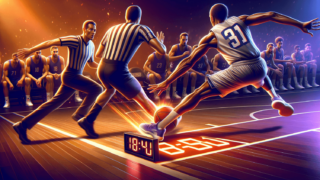
Out-of-Bounds Violation for Diving in Basketball
Written by: Basketball Universe
Last updated:

Grab your whistles, lace-up your high-tops and come along as we dive – or should we say, don’t dive – into the fascinating world of out-of-bounds violations in basketball. This blog post will introduce you to the ins and outs of one specific occurrence in the game that may just leave you scratching your head (and possibly get you a technical): the diving out-of-bounds violation. Whether you’re a budding basketball star or an eager fan looking to deepen your understanding, stay tuned and prepare to be a master in this seemingly paradoxical aspect of the game. Don’t worry – this journey promises to be both entertaining and informative!
Out-of-Bounds Violation for Diving in Basketball
An out-of-bounds violation for diving in basketball occurs when a player makes contact with the ball while any part of their body is touching the out-of-bounds area, or when a player leaves the court and returns without re-establishing their position inbounds. This results in a turnover, with the opposing team gaining possession of the ball. To avoid this violation, players must be mindful of their position on the court and exercise control while pursuing loose balls near the boundary lines.
Understanding the Basketball Court and Boundaries
Before we delve into the details of out-of-bounds violations, it’s essential to understand the basketball court dimensions and boundaries. A standard basketball court is typically 94 feet long and 50 feet wide, with the court divided into two halves. The sidelines run the length of the court, and the endlines run the width. The boundary lines or out-of-bounds area include the sidelines and endlines, which define the court’s playable area. While both professional and amateur games may have some variations, understanding these basic dimensions and boundaries is crucial when discussing out-of-bounds violations in basketball.
The Ins and Outs of Out-of-Bounds Violations
An out-of-bounds violation in basketball can occur in various ways, but they all share one thing in common: the involvement of a player, the ball, and the out-of-bounds area. Here are some standard scenarios that lead to out-of-bounds violations:
A Player Steps on or Crosses the Boundary Line
When a player with ball possession steps on or crosses the boundary line, they’re considered out-of-bounds. In this scenario, the opposing team gains possession of the ball. It’s essential for players to be mindful of their footing and positioning to avoid committing this violation.
A Player in Possession Touches the Out-of-Bounds Area
Similarly, if a player in possession of the ball touches the out-of-bounds area with any part of their body, an out-of-bounds violation occurs. Players must remain entirely within the playable area to maintain their inbounds status, as possession remains with the opponent in case of out-of-bounds.
Loose Ball Scenarios
An out-of-bounds violation can also occur when a loose ball rolls or bounces out-of-bounds. In this situation, the last player to touch the ball before it intersects the boundary line gets penalized with an out-of-bounds violation. As a result, it’s crucial for players to hustle for loose balls and be careful not to touch them when near the boundaries.
Diving into the Out-of-Bounds Violation for Diving in Basketball
Now that we’ve covered the basics of out-of-bounds violations, let’s take a deeper look at the specific act of diving out-of-bounds. Basketball rules state that a player must reestablish their position inbounds before making contact with the ball again after diving to save it in an out-of-bounds area. If a player fails to reestablish their position and interacts with the ball or the court, the referee will whistle an out-of-bounds violation against the diving player.
Reestablishing Position Inbounds
To reestablish their position after diving out-of-bounds, a player must ensure that both feet and any other part of their body are in contact with the playable area before they can legally touch the ball. Players who dive out-of-bounds must avoid returning to the court through endlines or sidelines as they attempt to regain possession of the ball.
Other Scenarios Involving Diving Out-of-Bounds
Aside from the primary out-of-bounds violation, other scenarios can arise during a game involving diving out-of-bounds. Here are a few examples:
A Player Dives Out-of-Bounds and Tosses the Ball to a Teammate
Suppose a player successfully dives out-of-bounds and manages to toss the ball back inbounds while still airborne. In this case, the player avoids committing an out-of-bounds violation if the ball reaches a teammate or opponent without the diving player landing out-of-bounds or on the court.
Illegal Returns Inbounds
If a player dives out-of-bounds and unsuccessfully returns inbounds, the referee will call a violation. A common example is a player returning inbounds without reestablishing their position, with the player’s body partly remaining out-of-bounds.
Tipping the Ball from Out-of-Bounds
Players who dive out-of-bounds and then attempt to tip the ball from the out-of-bounds area may also commit an out-of-bounds violation. It’s essential for players to be aware of their positioning and avoid touching the ball while any part of their body is in the out-of-bounds area.
Out-of-Bounds Violations and the Art of Diving Safely
To prevent out-of-bounds violations on the court, players must learn to dive and save the ball without breaking the basketball rules. It requires a keen awareness of the court and a sense of timing. Here are some tips to help players dive efficiently and avoid violations:
Anticipation and Awareness
Developing an ability to anticipate where the ball will end up is crucial to efficient diving. Players must be aware of their surrounding inbounds area, their opponents, and the approaching out-of-bounds area while they’re diving for the ball.
Controlled Movements
While diving for the ball, players must control their movements to avoid going out-of-bounds. It’s crucial to maintain body control even when making intense and quick moves, as this control can help prevent unnecessary out-of-bounds violations.
Proper Technique
Executing proper diving techniques is essential to both saving the ball and avoiding injury. Practicing diving skills can help a player become more controlled and effective on the court. Training inbounds diving techniques such as rolling or sliding can help mitigate unwanted penalties.
Teamwork and Communication
Good communication and teamwork are essential when diving for loose balls. Players should be aware of their teammates’ positioning, allowing the team to coordinate and decide who will dive for the ball and who will cover other players on the court. Effective communication helps prevent injuries and out-of-bounds violations.
Notable Out-of-Bounds Diving Moments in Basketball History
Diving out-of-bounds is an exciting and adrenaline-pumping aspect of competitive basketball. Some memorable out-of-bounds diving moments from both college and professional basketball games have left fans in awe. Here are some worth mentioning:
Larry Bird’s Diving Steal
Perhaps one of the most famous out-of-bounds diving moments came during the 1987 NBA playoffs. Larry Bird, playing for the Boston Celtics, stole an inbound pass from the Detroit Pistons and quickly flipped the ball back to a wide-open teammate for a game-winning layup. This incredible display of hustle, timing, and control remains one of the most iconic plays in basketball history.
Tyson Chandler’s Game-Saving Dive
In the 2011 NBA playoffs, Tyson Chandler made a game-saving hustle play by diving out-of-bounds in a fast-paced, high stakes game for the Dallas Mavericks. Chandler managed to tip a loose ball back to his team, preventing the Miami Heat from gaining an extra possession crucial for them in the dying minutes of the game.
NCAA Diving Heroics
Countless NCAA games boast heroic diving moments that have left fans on the edge of their seats. Players put everything on the line to dive out-of-bounds and save the ball, often leading to game-changing plays that define the careers of young athletes.
Conclusion:
Out-of-bounds violations in basketball, especially those involving diving, are both thrilling and nuanced aspects of the game that require extensive knowledge and skill. By understanding the basketball rules and practicing safe diving inbounds techniques, players can avoid violating out-of-bounds rules while maintaining the game’s intensity and excitement. So, the next time you watch a basketball game or step onto the court, remember the importance of diving safely and staying inbounds!
Out-of-Bounds Violation and Sportsmanship
While discussing the technical aspects of out-of-bounds violations for diving in basketball, it’s essential to consider the value of sportsmanship in the game. Players must maintain the spirit of fair play and respect, even when making moments of intense and emotional out-of-bounds dives. Here are some elements of sportsmanship to keep in mind:
Respecting Opponents and Officials
Good sportsmanship also involves respecting your opponents and the game officials. Whether you’re diving for a loose ball or contesting an out-of-bounds call, it’s essential to treat everyone on the court with courtesy and sportsmanlike conduct. Refrain from arguing with or disparaging opponents and officials when a call goes against you, as it ultimately goes against the spirit of the game.
Safety First
When diving out-of-bounds, players should strive to keep the safety of themselves and others in mind. Whether you’re diving near opponents or teammates, avoid causing injury or putting yourself in danger for the sake of an out-of-bounds play. It’s crucial to maintain control when diving and consider the potential consequences of your actions.
Playing Within the Rules
As with any aspect of basketball, playing within the rules is a fundamental component of sportsmanship. Committing excessive or intentional out-of-bounds violations to gain an advantage undermines the game’s integrity. Strive to adhere to the basketball rules and display good character both on and off the court.
Common Misconceptions About Out-of-Bounds Violations
Throughout the years, several misconceptions have emerged about out-of-bounds violations in basketball, causing confusion among fans and players alike. Here are some common misconceptions and clarifications:
Misconception: The Ball Must Land Out-of-Bounds to be Considered a Violation
Under basketball rules, a ball only needs to touch the out-of-bounds area to be deemed out-of-bounds, which includes any contact with the boundary lines, the floor beyond those lines, or any non-court object like a bench or stanchion. Contrary to popular belief, the ball doesn’t necessarily need to land out-of-bounds before it becomes a violation.
Misconception: Players Can Jump from Out-of-Bounds to Inbounds and Touch the Ball
One popular but erroneous belief is that players can jump from the out-of-bounds area, touch the ball midair, and land inbounds without violating any rules. As per the basketball rules, when a player contacts the ball with any part of their body while being out-of-bounds, they commit an out-of-bounds violation. Players must first reestablish their position inbounds before they can legally touch the ball again.
Misconception: A Player’s Entire Body Must Be Out-of-Bounds for a Violation
Contrary to popular belief, a player does not need their entire body to be out-of-bounds for an out-of-bounds violation to occur. If any part of a player’s body is touching the out-of-bounds area while they’re in possession of the ball, it is considered a violation. The same applies to players diving out-of-bounds while attempting to save a loose ball.
How Coaches Can Help Players With Out-of-Bounds Violations
Helping players avoid out-of-bounds violations for diving in basketball is an essential coaching responsibility. Here’s how coaches can contribute to developing their players’ understanding of these rules and situations:
Drills and Conditioning
Developing players’ strength, agility, and body control can contribute to preventing out-of-bounds violations. Coaches can implement appropriate conditioning and drills that help players exercise better control and awareness when diving for loose balls or avoiding out-of-bounds areas.
Education and Film Study
Understanding the rules surrounding out-of-bounds violations is crucial for players to avoid costly mistakes on the court. Coaches should emphasize the importance of knowing these rules and use film study sessions to analyze real-game scenarios, helping players visualize and comprehend the complexities of out-of-bounds violations.
Positive Reinforcement and Feedback
Coaches should highlight instances where players make correct decisions involving out-of-bounds diving situations and provide constructive feedback on areas that need improvement. Positive reinforcement and feedback can incentivize players to push themselves while maintaining a fun and engaging learning environment.
Frequently Asked Questions about Out-of-Bounds Violations for Diving in Basketball
Are you curious about out-of-bounds violations for diving in the game of basketball? Here’s a list of frequently asked questions to help clarify some of the concepts and quench your curiosity. Don’t see the answer you’re searching for? Dive deeper into the main article for more in-depth information.
1. What is an out-of-bounds violation?
An out-of-bounds violation occurs when a player with the ball or a loose ball touches the out-of-bounds area, which includes the boundary lines, sidelines, and endlines. This results in a turnover, with the opposing team gaining possession of the ball.
2. How can a player commit an out-of-bounds violation while diving?
A player commits an out-of-bounds violation while diving when they make contact with the ball while any part of their body is touching the out-of-bounds area or when they leave the court and return without re-establishing their position inbounds.
3. How can a player avoid an out-of-bounds violation while diving?
A player can avoid an out-of-bounds violation while diving by being aware of their position on the court and exercising control while pursuing loose balls near the boundary lines. They should also ensure they re-establish their position inbounds after leaving the court, with both feet and any other part of their body in contact with the playable area.
4. Isn’t a ball allowed to be in the air above the out-of-bounds area?
Yes, a ball is allowed to be in the air above the out-of-bounds area as long as it does not touch the boundary lines or the floor or any object beyond those lines. An out-of-bounds violation only occurs when the ball comes in contact with the out-of-bounds area.
5. Can one foot be out-of-bounds while touching the ball?
No, a player is considered out-of-bounds if any part of their body, including one foot, is touching the out-of-bounds area while they’re in possession of or in contact with the ball. In this scenario, the opposing team will gain possession.
6. If a player dives from inbounds and catches the ball fully airborne, is it still a violation?
If a player dives from inbounds, catches the ball fully airborne, and releases the ball to a teammate or opponent before landing out-of-bounds or on the court, there is no violation. The play will continue as normal.
7. How does a player “reestablish” their position inbounds?
A player reestablishes their position inbounds by ensuring that both feet and any other part of their body are in contact with the playable area of the court before they can legally touch the ball.
8. Can players touch the out-of-bounds area with their hands while saving the ball?
No, players cannot touch the out-of-bounds area with any part of their body while saving the ball. If they do, it’ll be considered an out-of-bounds violation, and the opponent will gain possession.
9. Why is diving such an exciting part of basketball?
Diving is an exciting part of basketball because it showcases players’ athleticism, commitment, and determination to save a loose ball and demonstrates their ability to maintain control and focus in high-pressure situations.
10. How can coaches help prevent out-of-bounds violations?
Coaches can help prevent out-of-bounds violations by implementing appropriate drills and conditioning exercises, emphasizing the importance of understanding the rules, providing constructive feedback, offering positive reinforcement, and promoting sportsmanship at all times.
Featured Posts
- No pillar pages found.





